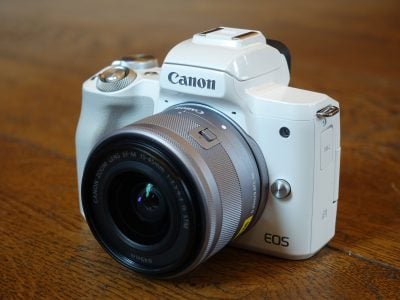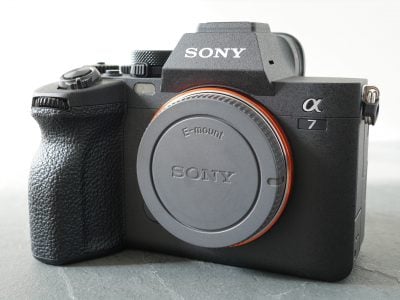Fujifilm FinePix F50fd
-
-
Written by Gordon Laing
Fujifilm FinePix F50fd lens and stabilisation
The Fujifilm FinePix F50fd is equipped with a 3x optical zoom delivering a somewhat pedestrian equivalent range of 35-105mm with a focal ratio of f2.8-5.1; the actual focal length is 8-24mm and we counted a relatively coarse nine steps when zooming from wide angle to telephoto. The closest focusing distance is 7cm in Macro mode with the lens zoomed all the way out. The camera’s pictured below powered down and with the lens fully zoomed-in.
The lens is probably the least exciting aspect of the whole camera. There are compacts which zoom wider, offer longer overall ranges, focus closer, or employ finer steps between focal lengths, but sadly the F50fd is quite average in all these respects. Don’t get us wrong, it’s not a bad lens, but it’s looking unremarkable compared to many rival compacts these days.
To illustrate the F50fd’s coverage we mounted it on a tripod and shot the same scene fully zoomed-out, then fully zoomed-in. We then shot the same scene from exactly the same position moments later using the Panasonic Lumix DMC-FX33 which is equipped with a 28-100mm equivalent range.
|
Fujifilm FinePix F50fd coverage wide |
Panasonic Lumix FX33 coverage wide | |
 | ||
8-24mm at 8mm (35mm equivalent) |
4.6-16.4mm at 4.6mm (28mm equivalent) |
It’s immediately clear from the coverage examples above how the 28mm equivalent of the Panasonic FX33 can capture a much wider field of view than the 35mm of the Fujifilm. This is not just useful for big landscapes, but equally handy for interiors, big group shots or situations when you can’t step back any further.
The examples below taken with each camera fully zoomed-in show the F50fd getting fractionally closer with its 105mm equivalent to the Panasonic’s 100mm, but there’s hardly anything in it. The Panasonic FX33 has a far preferable range and we wish Fujifilm had equipped the F50fd with a wider lens.
Fujifilm FinePix F50fd coverage tele |
Panasonic Lumix FX33 coverage tele | |
 |  | |
8-24mm at 24mm (105mm equivalent) |
4.6-16.4mm at 16.4mm (100mm equivalent) |
The F50fd features image stabilisation by physically shifting its sensor. The facility is activated by pressing a button on the far right side of the top surface and there’s two modes to choose from in the menus: Mode 1 applies stabilisation constantly, while Mode 2 only applies it when you half-press the shutter.
Fujifilm FinePix F50fd Image Stabilisation off / on | ||
 |  | |
100% crop, 8-24mm at 24mm, 1/60, 100 ISO, IS off |
100% crop, 8-24mm at 24mm, 1/60, 100 ISO, IS on | |
In use you could certainly see the benefit of the stabiliser on-screen, especially when zoomed-in, but in our tests we found it wasn’t as effective as rival cameras. Zoomed-in, we needed shutter speeds of 1/60 to eliminate camera shake (see above), while zoomed-out to wide angle, camera shake could still creep into shots taken at 1/15 or slower. Using other compacts at the same time we found we could enjoy sharp results at 1/8 or even 1/4 with stabilisation at wide angle focal lengths. So while the stabilisation worked, we found it less effective than on other models. See our F50fd Gallery for more details.
Fujifilm FinePix F50fd focusing and flash
 |
The F50fd offers three AF modes: Center, Multi and Continuous. The F-Mode menu also offers a Quick AF option which accelerates the auto-focusing performance, albeit at the cost of reduced battery life; this mode can be handy though for situations when you need the camera to respond quickly.
 |
The F50fd also offers Fujifilm’s Face Detection 2.0, which can work with or without red-eye reduction. In use a green square surrounds the primary subject, with white squares tracking up to nine other faces. During playback face detection can also be used to crop images for tighter portraits.
Fujifilm claims its latest face detection system can recognise faces even in full profile. In our tests with the F50fd it certainly managed a higher success rate with profiles than rival models, although it was still happier with the subject slightly turned to face the camera. That said, when the system did lock onto a face, it ensured the exposure and focus were spot-on, and the optional red-eye reduction mode successfully identified and retouched most demonic pupils in our test shots in dark interiors. Face detection can additionally be used to crop tighter portraits during playback if desired.
Fujifilm’s Intelligent Flash system also attempts to record more of the background in darker situations by increasing the ISO in fully automatic modes. In use this can certainly deliver nicer-looking compositions compared to the usual dark backgrounds in most flash photos, but in our tests the F50fd generally achieved this by using 800 ISO sensitivity. Consequently while more of the background was visible, the noise levels were much higher – see our F50fd Gallery for an example. You can force the F50fd to use a sensitivity of your choice though or limit the auto setting to a maximum of 400, 800 or 1600 ISO.
Fujifilm FinePix F50fd sensor and processing
The Fujifilm FinePix F50fd is equipped with a 12 Megapixel SuperCCD HR sensor, measuring 1/1.6in. This generates 4:3 images with a maximum resolution of 4000×3000 pixels, and there’s the choice of four lower resolutions or a cropped 3:2 aspect ratio mode. The top 12M mode is available in two resolutions, Fine and Normal, with the former typically measuring 4.5MB each; there’s 25MB of built-in memory to get you started and a dual-media memory slot which can take xD or SD cards.
 |
 |
 |
The image quality is selected from the F-Mode, where you’ll also find sensitivity. This is offered from 100 to 6400 ISO, with 3200 and 6400 ISO operating at reduced resolutions of 6 and 3 Megapixels respectively. You can see samples using the complete range of sensitivities on our F50fd noise results page.
Also in the F-Mode menu is an option to change the colour mode from Standard to the more vibrant F-Chrome mode or to Black and White. All our test shots were taken with the Standard mode.
Fujifilm FinePix F50fd movies
 |
Turn the mode dial to the movie camera icon and the F50fd can record video in either 640×480 pixels at 30fps, or 320×240 at 25fps. Files are recorded in the Motion JPEG AVI format and you’re looking at just over 1MB per second in the best quality mode; the maximum file size is 2GB.
The quality in the 640×480 pixel movie mode was good and the stabilisation certainly helped iron-out any wobbles. Note, like most digital cameras, you can’t adjust the optical zoom once you start filming.
Fujifilm FinePix F50fd burst shooting
 |
The FinePix F50fd offers a variety of continuous shooting options. Top 3 and Top 12 fire up to three or 12 frames at 2fps and 5fps respectively, although the latter operates at a maximum of 3 Megapixels and at no higher than 400 ISO. In tests we confirmed both shooting speeds.
Final 3 and Final 12 offer the same speeds and restrictions as above, but only record the last three or 12 frames after the shutter release has been released – handy to make sure you don’t waste frames before the crucial moments of action. All four of these modes operate with fixed exposure and focus once you start shooting, but a fifth Long Period mode can adjust focus and exposure on each frame, but with a 2.3 second interval between best quality images.





